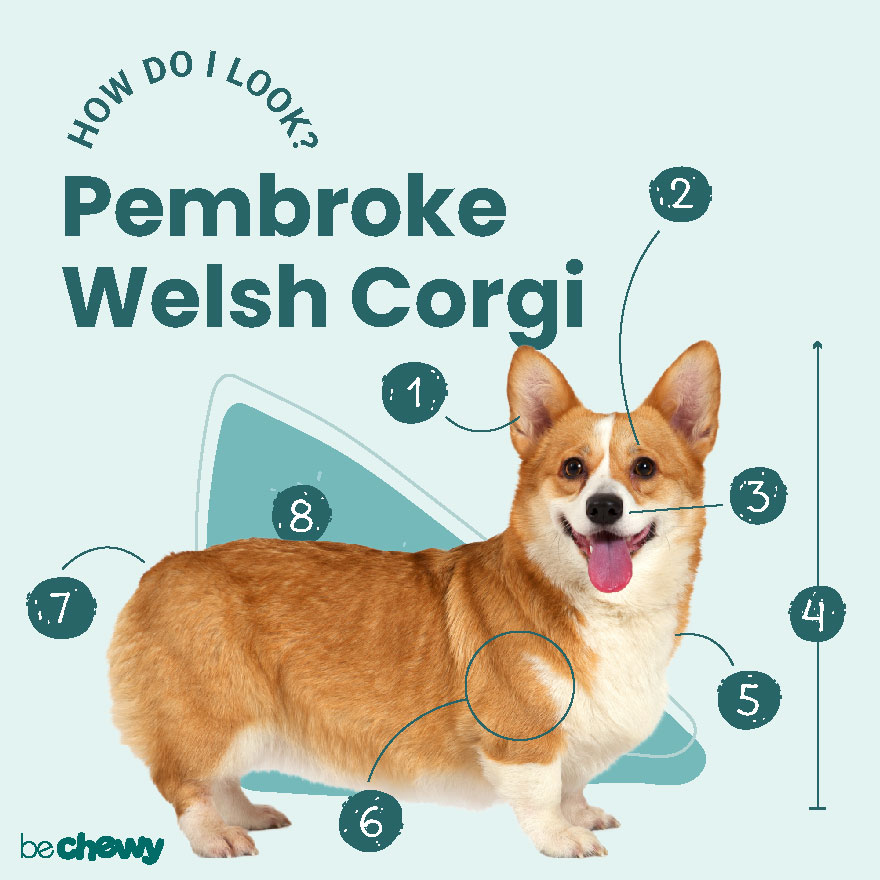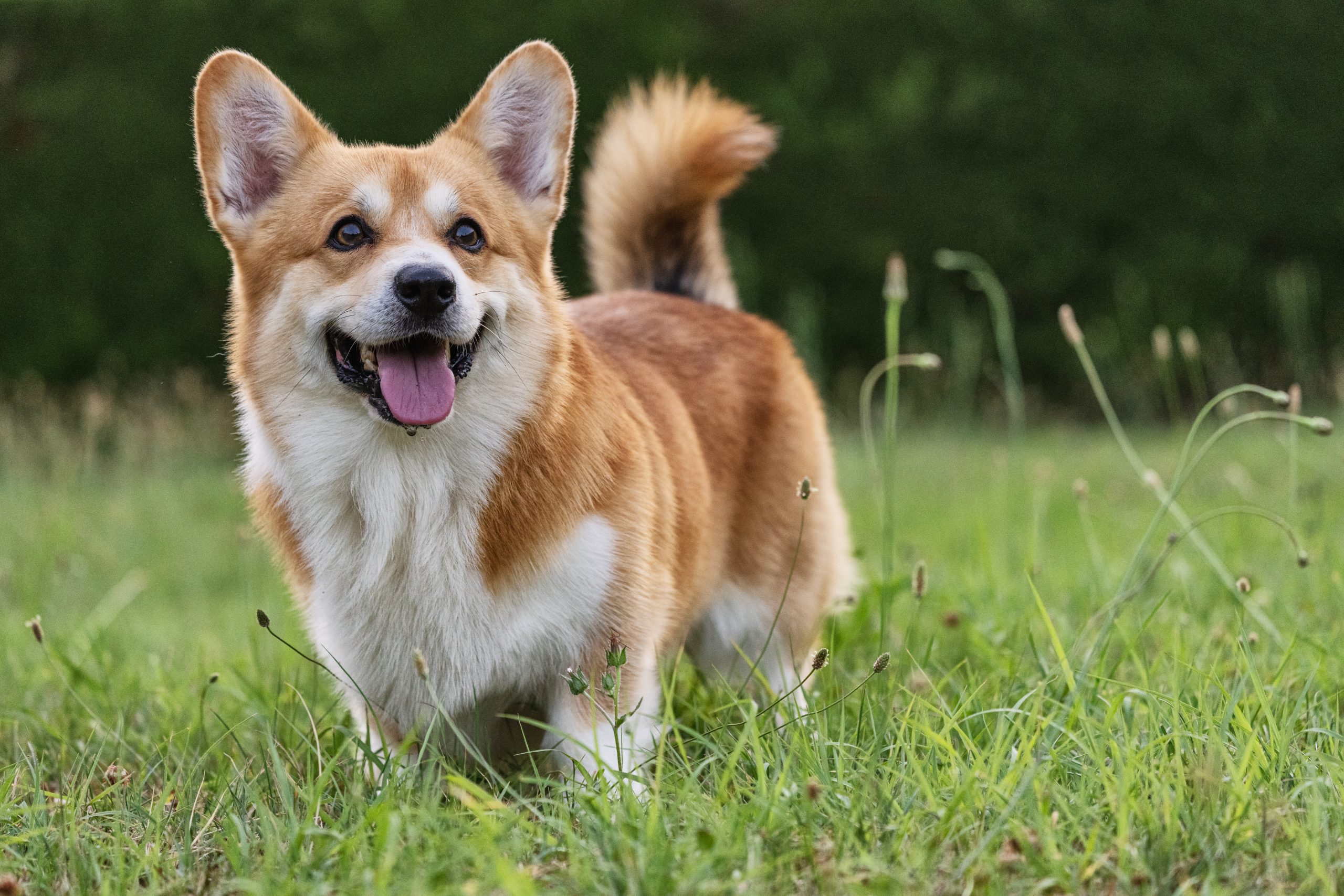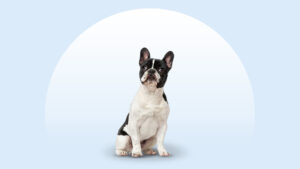Pembroke Welsh Corgi
Updated December 15, 2025
Pembroke Welsh Corgi
Updated December 15, 2025
Pembroke Welsh Corgis are adventurous social butterflies best for active pet parents who are able to not only meet their activity needs. Happy-go-lucky Corgis are very intelligent and high-energy, so they will need a good amount of training and socialization, too.
Energetic, Intelligent, Social Butterfly
Male: up to 30 pounds
Female: up to 28 pounds
Male: 10-12 inches
Female: 10-12 inches
12 to 13 years
Black and Tan, Fawn, Red, Sable
Life with a Pembroke Welsh Corgi is not for the shy. Why? Every stranger you pass will want to stop and say “hello” on your walks—and your Corgi will welcome all the extra attention. You’ll be taking lots of walks, too, because these energetic pups love a good adventure. (But with their little legs, your outings will need to be short.) This adorable dog enjoys making new friends, but rest assured: You’re the only person they want to snuggle up with at the end of an activity-filled day.
Pembroke Welsh Corgi Characteristics
Pembroke Welsh Corgi Appearance
With perky ears and large, expressive eyes, a Pembroke Welsh Corgi puppy could be mistaken for an adorable stuffed animal. As they get older, the dog grows into their characteristically long, slinky body but retains the goofy smile of their puppyhood. Short in stature, stocky and sturdy, Corgis are surprisingly agile and fast. They’re known for their floofy backsides that are missing a tail, often called “momo,” which is Japanese for peach. And if you google “Corgi sploot,” we guarantee you will not be disappointed.

- Ears
Pembroke Welsh Corgi ears are erect, medium-sized and taper to a rounded point.
- Eyes
Their eyes are oval, and their color is a variation of brown that harmonizes with their coat color.
- Nose
Pembrokes have black noses.
- Coat Length
Corgis have double coats: a short, thick and weather-resistant undercoat and coarser, longer outer coat. The fur is medium length and slightly thicker around the neck, chest and shoulders.
- Coat Color
Their colors can be black and tan, fawn, red or sable with white markings.
- Tail
The AKC breed standard calls for the tail to be docked as short as possible. Docking involves cutting a portion of the dog’s tail off when they are puppies. Veterinary groups along with many US states and countries have banned this procedure due to medical and behavioral reasons. If you are interested in this procedure, schedule a consultation with your veterinarian.
Pembroke Welsh Corgi Temperament
The happy-go-lucky Pembroke Welsh Corgi loves life. This breed makes the most of every moment, whether they’re capturing the attention of everyone at the park or bonding with their family at home. The Corgi is independent, bold and adventurous—they want to go out and explore the world—but they won’t explore too far without their favorite person. (Hint: That’s you.)
Social interactions and training are important to curb their herding instincts. They’ll often nip the heels or feet of those who move too quickly around them, especially young children or other pets. This means they will explore new things with their mouth (often by biting or chewing), which can be particularly painful when it comes to those puppy teeth, and can also be off-putting to other dogs as they get older. In general, though, they enjoy playdates with other dogs, especially those who can match their energy level.
Corgis aren’t known for being aggressive or biting. Still, they pack the personality of a big dog into their little bodies, including a strong-willed streak. That’s another reason why early socialization and training are so important. It’s also important to teach children how to interact with dogs.
These short stacks can make excellent family members—as long as they get regular exercise to burn off their generous supply of energy. While Corgis love to play with toys, they really need a daily long walk. Some Pembroke Welsh Corgis may enjoy a slow jog, but their short legs make it too difficult for them to keep up with a bicycle or someone running very fast. (They are not known to be very speedy.)
How to Care for a Pembroke Welsh Corgi
Raising a Pembroke Welsh Corgi is rewarding but takes some effort. Corgis are very intelligent and high-energy, so your dog will need a good amount of training. Thankfully, grooming them isn’t especially complicated or time-consuming. These small dogs seem to have fun no matter what they’re doing, as long as they’re with their person, so you’ll likely find yourself looking forward to the tasks involved in caring for them.
Grooming
Training
Diet
Exercise
Environment
Pembroke Welsh Corgi Health
Pembroke Welsh Corgis have a life expectancy of 12-13 years, and the breed is prone to several health issues. Knowing what these health problems are and purchasing your pup from a reputable breeder can help ensure your dog lives a long and happy life. If you’re adopting a dog, be sure to get a copy of the vet wellness exam.
- Elbow and Hip Dysplasia: Dysplasia is more common in larger breeds but can occur in any dog. Canine elbow dysplasia occurs when the elbow doesn’t develop properly and eventually causes pain, lameness and eventually arthritis. Hip dysplasia is when the ball and socket of the joint don’t fit together properly and the joint grinds, which eventually wears the joint down. Treatment may include joint supplements, anti-inflammatory medication or even surgery.
- Cataracts: Corgis often develop cataracts, which is when their eyes become cloudy and may eventually lead to blindness. Many dogs adjust to vision loss, but surgery is sometimes an option.
- Patent Ductus Arteriosus (PDA): PDA is the condition where the small vessel that carries blood between two parts of the heart does not close shortly after birth. Vets listen for a specific heart murmur, and surgery is often required to close the blood vessel.
- Degenerative Myelopathy: Because of their long bodies, Pembroke Welsh Corgis are highly susceptible to degenerative myelopathy, which is a chronic, progressive and often fatal disease of the spinal cord. Unfortunately, there is no treatment, but genetic screening testing is available.
- Von Willebrand’s Disease: This blood clotting disorder can be identified with a blood test and is important to check for before your Pembroke Welsh Corgi undergoes surgery. Most dogs do well in everyday life but may need a blood transfusion if they have a trauma or surgery.
Pembroke Welsh Corgi History
The origin of the Pembroke Welsh Corgi dates back to the medieval period, when the kings of Europe showed off their luxurious carpets, textiles and tapestries to demonstrate their wealth. At the time, Flemish weavers were considered the most skilled, and kings often encouraged the weavers to relocate to their kingdoms. In 1107, Henry I of Britain invited a few Flemish weavers to move to southwestern Wales, and the weavers brought the dogs they bred to herd cattle and sheep with them. Those dogs became what we now know as Pembroke Welsh Corgis.
Best known as Queen Elizabeth II’s favorite breed, Pembroke Welsh Corgis have risen in popularity as a pet in the United States in recent years and are more popular than their cousin, the Cardigan Welsh Corgi. (Originally considered one breed with two types, the two have been separate breeds since the 1800s.) The American Kennel Club recognized the Pembroke Welsh Corgi in 1934, and the breed is No. 13 on the list of most popular breeds in the AKC.
Are you looking to add a Pembroke Welsh Corgi to your life? You can find a list of reputable breeders on the AKC’s website. Depending on the breeder, a Pembroke Welsh Corgi price averages $1,000-$2,000. For that, you usually get a puppy who’s been screened for health and temperament issues and may come with pedigree papers. If you’re looking to adopt, contact a Corgi rescue group or look out for the breed at your local animal shelter. You can also search Chewy’s database of adoptable dogs in your area.
FAQs
Do Corgis shed?
What is the difference between a Pembroke and Cardigan Welsh Corgi?
Are Corgis good with kids and cats?
Are Corgis smart?
What are the most popular Corgi names?
What are the most common Corgi mixes?
Expert input provided by Dr. Mandy Boos, a veterinarian at Laurel Veterinary Clinic in Broomfield, Colorado; and Mindy Jarvis, ABC-CPDT, CGC evaluator and owner of Noble Beast Dog Training in Denver, Colorado.
Breed characteristic ratings provided by Dr. Sarah J. Wooten, DVM, CVJ, a veterinarian at Sheep Draw Veterinary Hospital in Greeley, Colorado; dog trainer and behavior consultant Irith Bloom, CPDT-KSA, CBCC-KA, CDBC, owner of The Sophisticated Dog, LLC, in Los Angeles; and certified animal behavior consultant Amy Shojai, CABC, in Sherman, Texas.
The health content was medically reviewed by Chewy vets.








